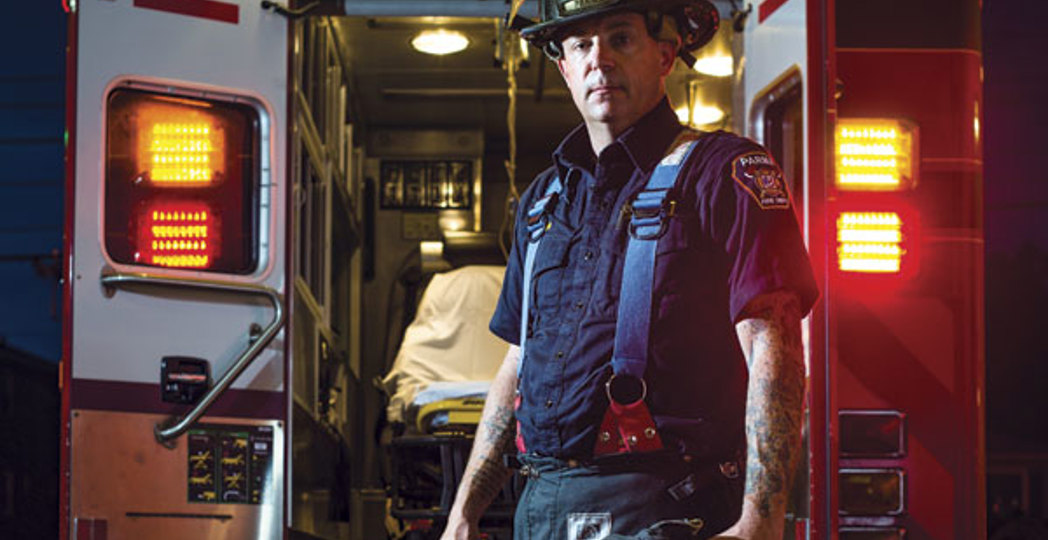Our Epidemic: Responding To A Crisis
by Sheehan Hannan | Sep. 11, 2017 | 6:00 PM

Angelo Merendino
David Knecht has battled death for more than 20 years. A firefighter and paramedic, Knecht joined the Parma Fire Department in 1999 after five years with Cleveland Emergency Medical Service. With Parma hit hard by opioid overdoses, the 48-year-old Navy veteran has witnessed his department’s use of Narcan jump from 166 doses in 2014 to 347 in 2016.
I’ve learned that these people are struggling with something I know nothing about — and that’s addiction.
My very first overdose of an opiate, which happened to be heroin, was in 1997. She was extremely agitated, upset that we ruined her buzz, somewhat violent because we took it away from her. This girl was literally on death’s door.
But I saved a life.
Our first-line drugs used to be all cardiac medications. Now our first-line drug is Narcan. It was quick-acting back then, where now it takes some time.
Back in the day, heroin used to be done in dark alleys and shooting galleries. Now it’s done in a $175,000 house or an apartment.
It doesn’t matter if you’re white, black, male, female, rich, poor, own your home, rent, employed, unemployed. Heroin doesn’t discriminate. It doesn’t care. Nor does it care where you use it. I’ve had overdoses in basements and in bathtubs.
Recently, I had one in a backyard in a tent during a downpour. The family had kicked the individual out of the house because they were tired of their drug habit.
The signs you’ll see [of overdose] are snoring like they’re in a deep sleep. They may be sweaty. They’ll be more or less blue or purple.
One of the side effects of an opiate is as a respiratory depressant. Our first priority is to get a patient’s breathing back up. That’s what Narcan does.
Some people are under the misconception that you jab somebody in the heart with [Narcan]. Well, that’s not how it works.
We almost instantly grab two Narcan, a device that goes into the nose, and we’ll spray 1 milligram in each nostril. We [use a bag valve mask] to put air into their lungs. It forces the Narcan down into the nose and airway.
As we’re pushing that medicine, we’ll attempt to get an IV right there, so we can give our next dose via IV, which is the most direct way [to administer Narcan] and has the most punch.
You’ll see the color start to come back to their body, into a more normal state. You’ll see a decrease in sweating. I’ve noticed lately there are more people puking afterward.
I’ve never stopped learning or knowing that they’re human beings, and they still deserve the same respect that an 89-year-old lady having chest pain would get.
Certain individuals are repeat customers, basically. Their tolerance is getting higher and higher. I had one guy I gave 22 milligrams. That’s the most I’ve ever given. That was our second call in a row for heroin.
He was found in a basement, sitting upright, completely purple, police standing over top of him. He was on the couch. They had already given him 4 [milligrams], so they were tapped out.
There was a large German shepherd sitting next to him that could have cared less. It was sitting there like, OK, you guys have been here before.
Got an IV, gave [the Narcan]. Followed it with a flush of saline. Nothing. Slight responsiveness, maybe. He was kind of moaning. Still snoring, still unresponsive. Pupils still pinpoint.
On the 20th [dose], when we pushed the last 2 milligrams, maybe two to three minutes afterward, he started becoming more alert. After maybe five minutes he was fully alert, like you and I are. We took him to the hospital. He left.
As we’re leaving the hospital, we got a call for another one. He was found in the parking lot of a convenience store. He only took 6 milligrams.
Trending
-
1
-
2
-
3
-
4
-
5










